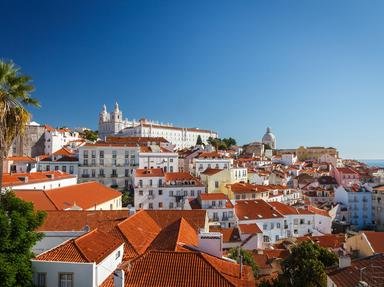Quiz Answer Key and Fun Facts
1. As we fly into Lisbon, Portugal's largest city, I think back to the events of November 1st, 1755. What happened?
2. There are four of us traveling, and we have more luggage than any Portuguese car can hold. We have to drive from Lisbon to Oporto to pick up the single adequate rental car available that has a trunk larger than my glove compartment. The rear seat passengers survived the trip to Oporto, except for minor crush injury under all the luggage as if their air bags were deployed for the entire ride. In Oporto, we head for the "lodges" on the banks of the Douro river. What does one find in these lodges?
3. As we drive around sightseeing, everyone tells us to see the "barcos rabelos". What are these?
4. We are quite giddy as we leave Oporto, likely due to the "angel's share" , which has clouded our sensorium. What is the "angel's share"?
5. We cross the elegant arched and two-tiered Dom Luis I bridge, designed by an assistant of Gustav Eiffel and leave the city. We ultimately head northwest to Guimares, Portugal's original capital, to stay in a medieval monastery converted to a hotel. Portugal has a network of these historic hotels analogous to the famous Spanish paradors. In Portugal, these state-run historic hotels are called what?
6. We travel to historic Tomar, and visit the Templar's castle, which cannot be described in words, but has to be experienced. Whetting our appetite for history, we continue on to one of Portugal's crown jewels: the Dominican abbey of Santa Maria da Vitoria at Batalha. The unique elaborate style of architecture here has been given its own designation. What is this style called?
7. When visiting Portugal, one cannot avoid seeing the exquisite painted tiles everywhere: on ceilings, walls, floors, and every other conceivable item, such as benches, stoves, and panels. What is the name given to the tiles of this characteristically Portuguese form of art?
8. What product of Quercus Suber is very important to the Portuguese economy?
9. In Lisbon, what guard tower built in the Tagus river in 1515 is many times used as a symbol of the city?
10. Where would you find acordas, caldeirada, and bacalhau?
Source: Author
jstagamtome
This quiz was reviewed by FunTrivia editor
minch before going online.
Any errors found in FunTrivia content are routinely corrected through our feedback system.

